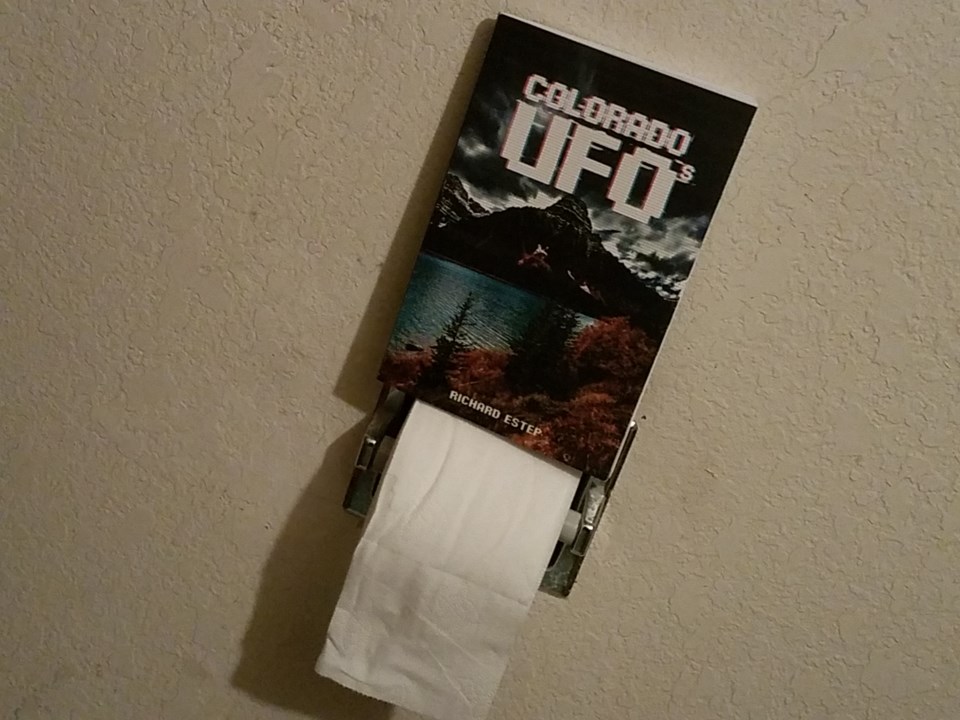This content was originally published by the Longmont Observer and is licensed under a Creative Commons license.
The author Richard Estep, who happens to be a Longmont resident, and no pushover when it comes to alien phenomena, wrote a book that should be pushed over, further, further, a little bit more, and off the bookshelf into the trash can.
Colorado UFOs is so full of filler, reading it felt like I was being force-fed Taco Bell “meat” with a previously used anal probe. I wanted this book to be good, as a positive Longmont representation, with alien events in our backyard of Colorado and all, but it just disappointed me in a way I wouldn’t have expected. It was cool to read stories with towns, cities, roads, and landmarks that I am familiar with, but you don’t have to be a skeptic of UFOs to see its cheap taco meat quality.
Before I opened this book, I thought if there was a chance that I wouldn’t like this, it would have been because he was a UFO nut job with a brain from another solar system, but he wasn’t. Estep was actually the sanest person in this book. And he was in the book, annoyingly pointing out to the reader many times over and over that, “as he was writing the book,” blah blah blah, this and that, look at me I’m a writer writing a book. He adds a running narrative of him writing the book, and doing certain activities for the book, which is unnecessary to present information like this and just absolute lazy, easy filler.
I want to believe. I’m a sucker when it comes to this UFO stuff and very enthusiastic to find any semblance of evidence of aliens. I’m a very open-minded person, but this galactic bantha fodder of a book wouldn’t persuade the naïve high school me in the 90s high on fumes from watching The X-Files.
Although, Estep wasn’t trying to persuade the reader with facts, just strongly instill the benefit of a doubt that this could have happened, playing devil’s advocate, or alien’s advocate, with his retelling of stories from multiple people who have encountered aliens. He merely presents the re-tellings as they were told to him by other people, and the reader can believe them or not, as mentioned in the preface.
In the preface, Estep writes, “‘Don’t rehash the same old reports and troll from existing websites,’ I was cautioned when we were laying down the parameters of the book… I’m also pretty sure that you, dear reader, wouldn’t be all that interested in handing over your hard-earned cash for such a book. Not when the same information could be easily gleaned by a Google search.”
Chapter 2 is about that crazy-eyed horse Blucifer outside DIA, and the odd art on the inside of the airport. You don’t need to Google search this because you’ve probably heard about this by word of mouth. You don’t even have to pull out your phone to hear this, you could just listen to the person rambling on next to you on the bus about conspiracy theories.
This chapter doesn’t even address aliens and UFOs and fails to even come back later in the book to what was mentioned in this chapter. It’s just a random island of Taco Bell meat. OK, some of it is about NORAD, but Estep is such a paranormal writer that he couldn’t stay away from straying off to his favorite subject for a chunk of filler.
In Chapter 3, only thirty-something pages from what he wrote in the preface, this information is an easy Google search away, or a bus ride away, of UFO sightings covered by several popular news sources. He doesn’t even know the sources that he is citing, calling the Daily Camera a Longmont-based newspaper. It has never been a Longmont newspaper in the entire history of its existence, and never will be. It seems like Estep doesn’t even know how to click on an ‘About Us’ in the limited rushed time this poor excuse for a book was probably written in.
Maybe a third of this book is original researched information. One of the bigger chapters, Chapter 4, is about a coworker’s alien abduction experience. Now that’s just abominably lazy writing and way too convenient—the 7-Eleven of alien stories. It couldn’t have taken him more than a few weeks to research and write this book. The other bigger chapters could have been conducted in one weekend in a string of interviews with associated alien believers in the San Luis Valley.
In several of the other chapters, he roughly weaves a narrative of these aliens called the Greys and the Crustaceans through a convenient handful of people who encountered them. Other than his coworker’s abduction, this is the only other original information in this book, and it’s only recounted by a few people mostly in the San Luis Valley.
Do you want to ponder what is really out there? This book will certainly evoke those thoughts, but there are plenty of other books on this planet that would do that better, with several times the amount of information this book provides, and for a cheaper price. I’m not dumping on this book as a nonbeliever. I’m dumping on this book because this is a bad book, poorly researched, halfheartedly executed, and no one should throw away $16.99 for a filler-filled measly 125 pages.
The book could be read in a few hours or broken up into a month’s read on your moving bathroom breaks. Ten years ago, I would’ve called Colorado UFOs a bathroom read, especially with the book’s short chapters and sub-chapters, but smartphones have nearly eradicated these types of books. The target audience is very small for this book. It’s perfect for a middle school student who is an avid bathroom pooer without a smartphone, and has already read everything under the sun about UFOs several times over.



